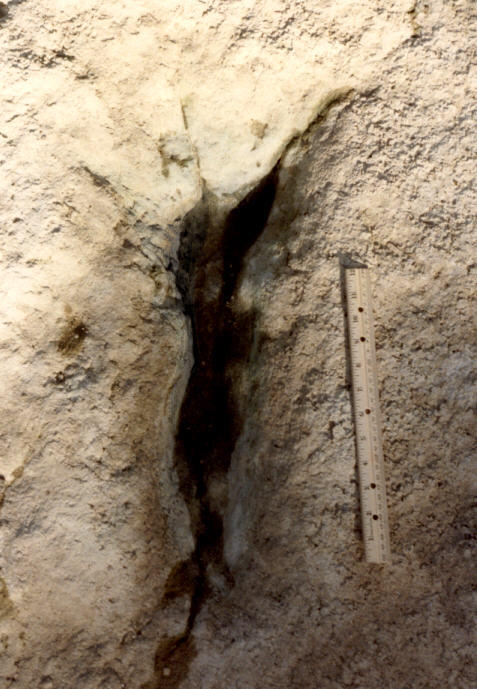The Three Main Paluxy "Man Track" Phenomena
All photos and illustrations © 1980 - 2022, Glen J. Kuban. except where otherwise noted
http://paleo.cc/paluxy/Paluxy-summary-2022.htm
Note: Click on any image for larger version (then hit BACK key to return to article)
Introduction
For many years young-earth creationists (YECs) often claimed that
human footprints or "giant man tracks" occur alongside fossilized dinosaur tracks in
the limestone beds of the Paluxy River near Glen Rose, Texas. They often cited
the tracks as compelling evidence for their belief that the earth and all life on it
was created only several thousand years ago by divine fiat, rather than having evolved
over many millions of years as is held by most earth scientists. However, the
"man tracks" have not stood up to close scientific scrutiny, and since the 1980's
(when I published detailed refutations of them) the alleged Paluxy "man tracks"
have been largely abandoned by YECs, except for a few disreputable individuals and ultra-fringe groups.
The supposed human tracks involved a variety of phenomena, including forms of
metatarsal (heel impressed) dinosaur tracks, erosional markings, and a smaller number of
carvings (most on loose blocks of rocks). Below are more details and illustrations of
each type.
1. Metatarsal (heel-impressed) Dinosaur Tracks
The largest number of alleged Paluxy "man tracks", including those on the renown "Taylor Site", were forms of elongate, metatarsal
dinosaur tracks, made by bipedal dinosaurs that sometimes impressed their metatarsi (heels and soles) as they walked.
When the digit impressions of such tracks are subdued by infilling, mud-collapse, and/or erosion, the oblong depressions at
the rear often superficially resemble large human footprints, for which they were often mistaken by creationists. However,
none show clear human toes, and when well-cleaned and closely examined, these tracks show strong indications of a three-toed,
dinosaurian digit pattern. Several trails of such tracks at the renown "Taylor Site" one claimed to be human
(Taylor Trail, Turnage Trail, Gian Run Trail, and Ryals Trail) are all well-infilled versions of metatarsal dinosaur
tracks, as are other trails on the site.
Having initially missed these features, these tracks were heavily promoted in the widely viewed creationist
film Footprints in Stone, produced by Stan Taylor and associates in 1970, as well as many YEC articles
and books during the 1970's and early 1980's, including the book Tracking Those Incredible Dinosaurs (1980)
by John Morris of ICR. However, after Morris and other YEC representatives accepted my invitation to meet me
on the sites in 1985 to reevaluate their evidence, subsequently ICR, Taylor, and most other YECs backpedaled
from their claims. At that time I pointed out that all of the tracks showed at least some shallow relief indicating
dinosaurian digits as well as color and texture features relating to infilling material that further highlighted the
track shapes and confirmed their dinosaurian nature. The YECs acknowledged in subsenquent public statements that
their human track claims were in serious doubt, although they stopped short of full and frank retractions, and
depicted the Taylor Site tracks as "mysterious" and needing more research (even though in over 25 years they evidently
have done no further research there). Morris also made a groundless insinuation that the colorations might be
artificially applied stains, but several compelling lines of evidence (including core sample), confirm that
they relate to secondary sediment infillings, as detailed in my article on Color Distinct Tracks (Kuban, 1986).
Moreover, all Taylor site "man tracks" show at least some relief corresponding to the dinosaurian digits,
and the same infilling/coloration features can be seen on some of the tracks even in early YEC photos.
Many other metatarsal tacks also occur in the Paluxy (some claimed to be human and others not). Decades ago
some locals mistook eroded or mud collapsed metatarsal tracks for "moccassin prints." In more recent years
trails of indistinct metatarsal tracks on the coarse-surfaced McFall Ledge have been promoted by some YECs,
especially Carl Baugh and assicates as, human tracks or human tracks overlapping dinosaur tracks. Baugh has also promoted
other some loose carvings, and selectively highlighted or doctored erosional features as human tracks (the other types
of alleged "man tracks" discussed below).
The Alfred QWest track site illustrates the variability of metatarsal tracks and their ability to produce human-like shapes.
Although largely ignored by YECs, it contained several trails of such tracks. Some were well preserved and showed
clear dinosaur digits; others were somewhat mud-collapsed or eroded (even in the same trails) and thus more human-like.
Most metatarsal tracks in the Paluxy were evidently made by slender ornithomimid ("ostrich mimic") dinosaurs, which were
smaller than Acrocanthosaurus which made most of the large 3-toed tracks in the Paluxy. Metatarsal tracks may
have been made when dinosaurs walked with a somewhat crouched posture while contending with soft or slippery substrates,
and/or while foraging for small food itemns in the mud and shallow water. Metatarsal dinosaur tracks from a variety of
theropods and ornithopod dinosaurs are also known from many other sites throughout the world.
In summary, metatarsal dinosaur tracks are fairly comnon in the Paluxy. When the digit impressions of such tracks
are subdued by infilling, mud-collapse, erosion, or a combination of factors, they often superficially resemble
large human footprints.
Taylor Site, 1984
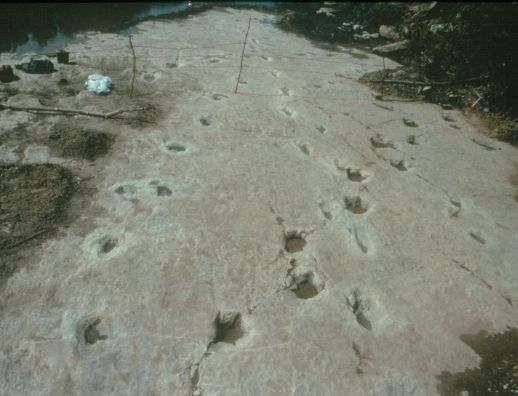
|
|
High overhead view of Taylor Site (1984), containing several trails once alleged to be
human. The renown Taylor (IIS) Trail proceeds from bottom-center to upper left. It and the Turnage (IIN) Trail, in the lower
right, cross the "Deep Dino" (IID) trail. The "Giant Run" (GR) Trail proceeds toward
the center-right. Other alleged human tracks at the site are outside the photo.
|
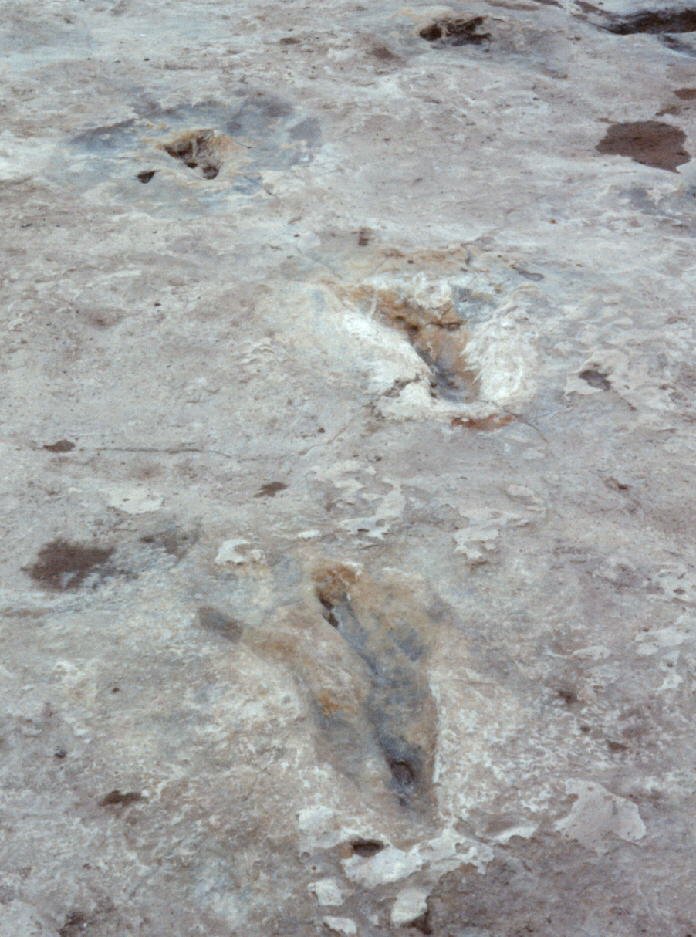
|
|
Taylor Trail, 1984.
Track IIS+4 at bottom. Note the
blue-grey and rust-brown coloration features
corresponding to infilling sediment, indicating
dinosaurian digits.
|
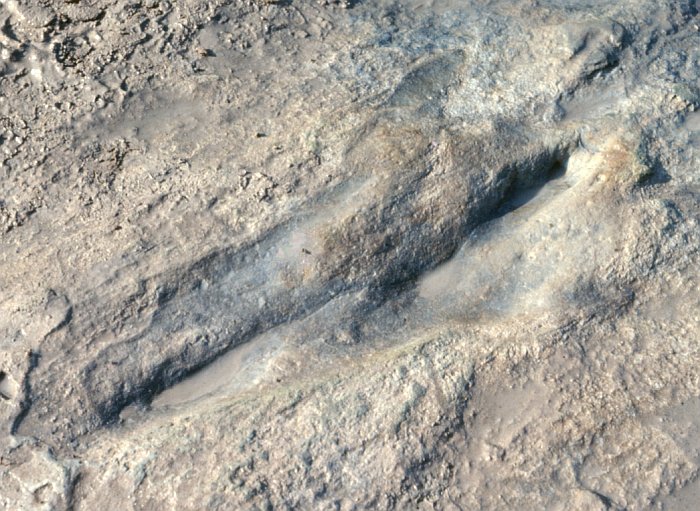
|
|
Track IIS+4, photographed at a low angle and showing distinct color and texture
contrasts between the infilling (darker) and the surrounding limestone. Note the well defined digits and
metatarsal segment, with only slight topographic relief. These same features can be seen in the film Footprints in Stone.
|
More Taylor Site 1984

|
|
Taylor Trail, 1984.
Track IIS+2 at bottom. Note 3-toed dinosaur digit patterns of infilling
material at anterior of the tracks.
|
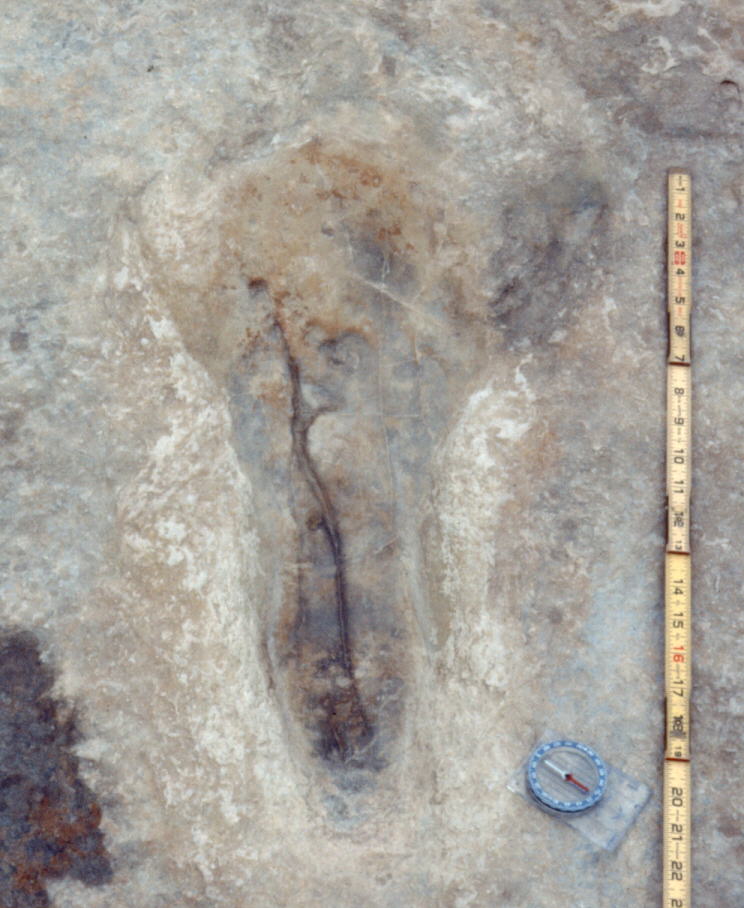 |
|
Taylor Trail track IIS,+3, showing unusually rounded anterior, possibly due md pushed forward by
the middle digit, but still shows a tridactyl pattern.
|
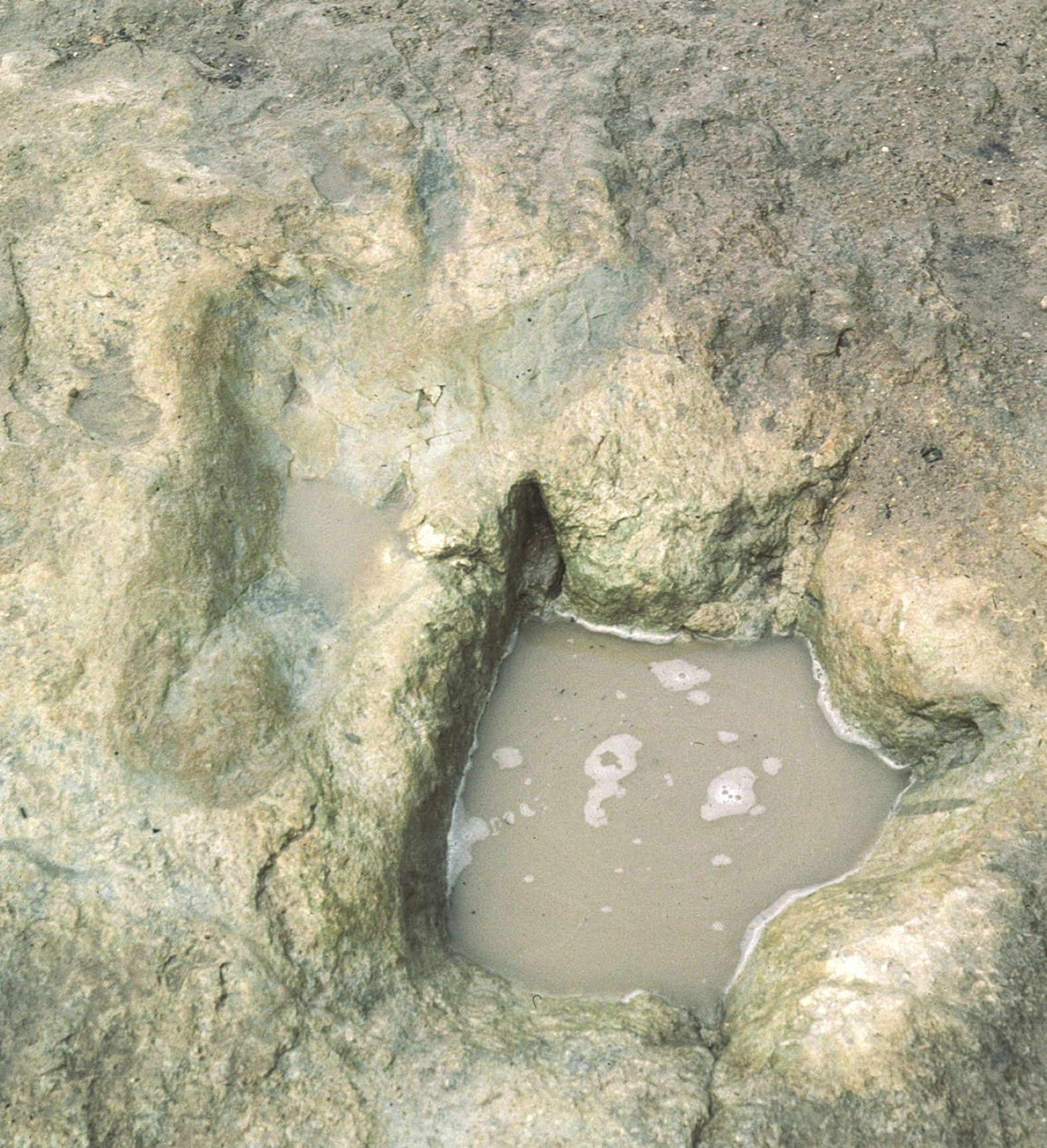 |
|
Taylor Trail track -4 (upper left)
showing blue-gray infilling indicating dinosaurian
digits. YECs once called this a human track
overlapping a dinosaur track.
|
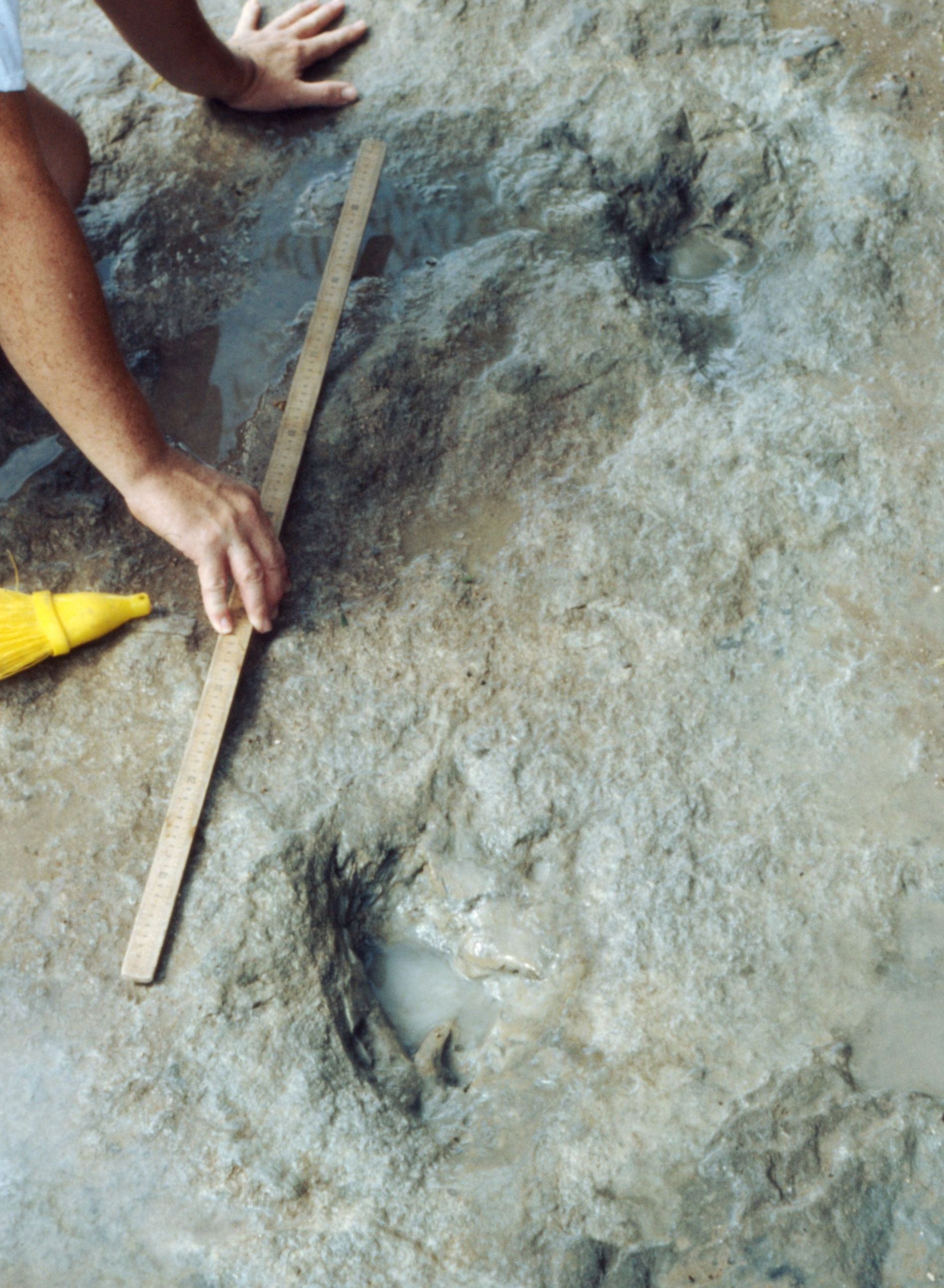 |
|
Turnage Trail (1984) at Taylor Site, once
mistaken as human by YECs who missed the infilling features
indicating dinosaurian digits.
|
-------------------------------------------------------------------------------------------------------------------------------------
Taylor Site, 1985, Under shallow water (showing more dramatic infilling contrasts)
|
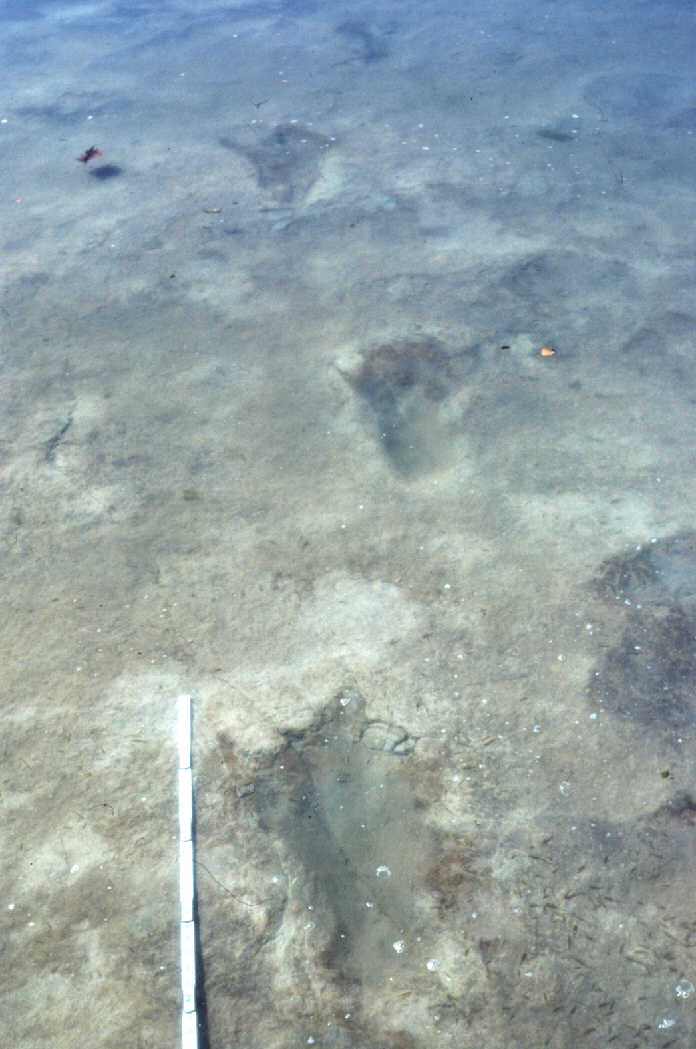 |
|
Taylor Trail, under shallow water, 1985. The
infilling areas are more rusty-brown than
in 1984, providing distinct contrast with the
limestone substrate. Track IIS,+2 at bottom.
|
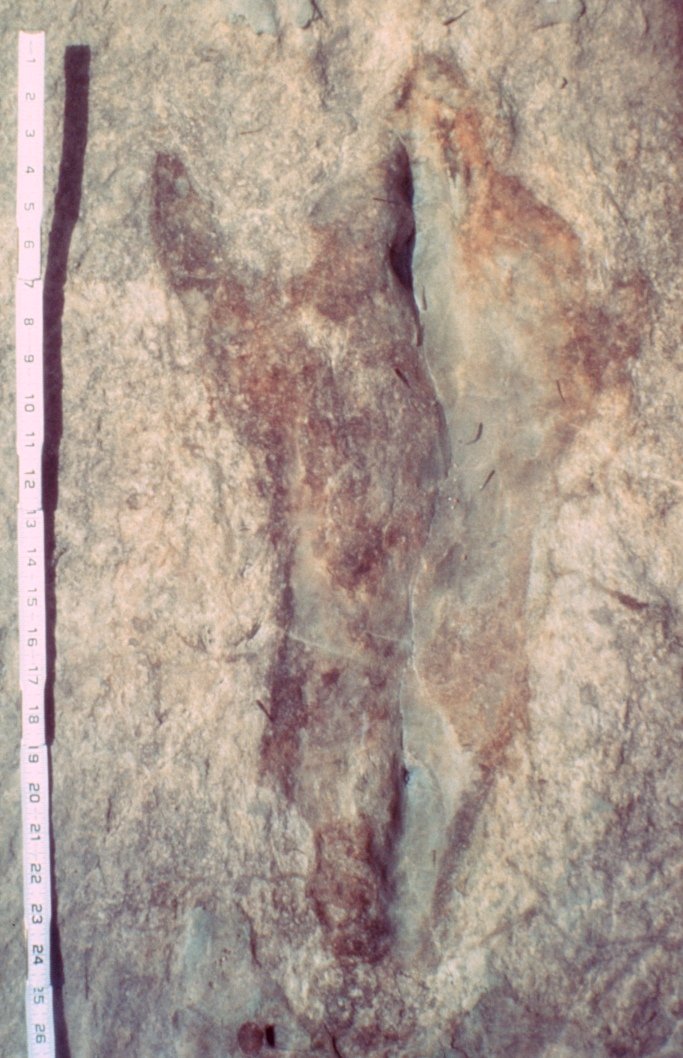 |
|
Taylor Trail track IIS,+4 (a left).
This track shows little topographic relief but distinct color
and texture contrasts related to the infilling material. The
same outline can be seen in the 1970 film Footprints in Stone.
|
 |
|
Taylor Trail track IIS,+3 (a right).
The rounded front of the track is evidently due to
the way the mud was pushed up by the "ball" of the
dinosaur's foot, and/or a wide pad at the base of
the middle digit. |
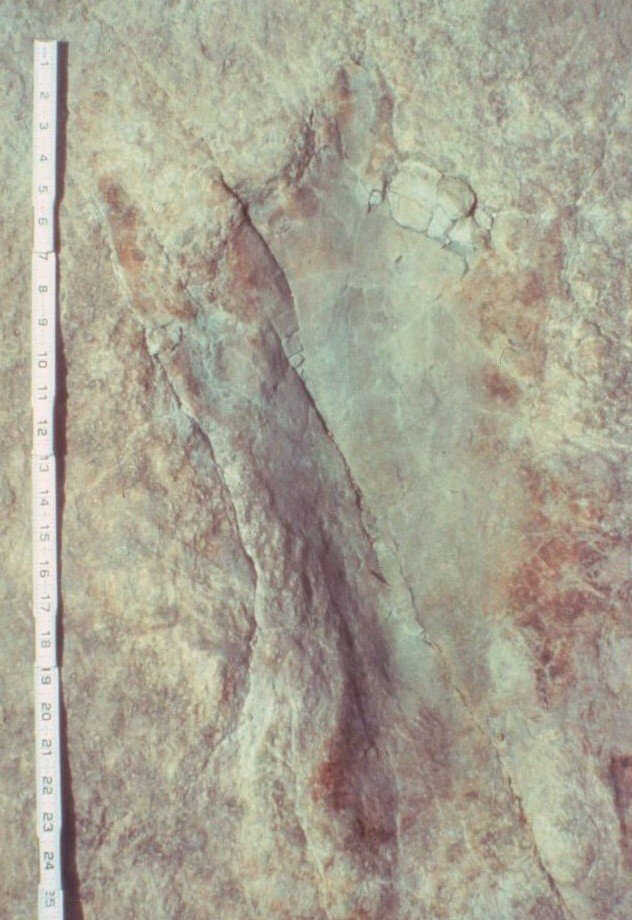 |
|
Taylor Trail track IIS,+2, 1985, under shallow water,
showing rust-brown coloration at the highest parts of the track
(the sides and digits) and blue-grey coloration
in the deeper middle region.
|
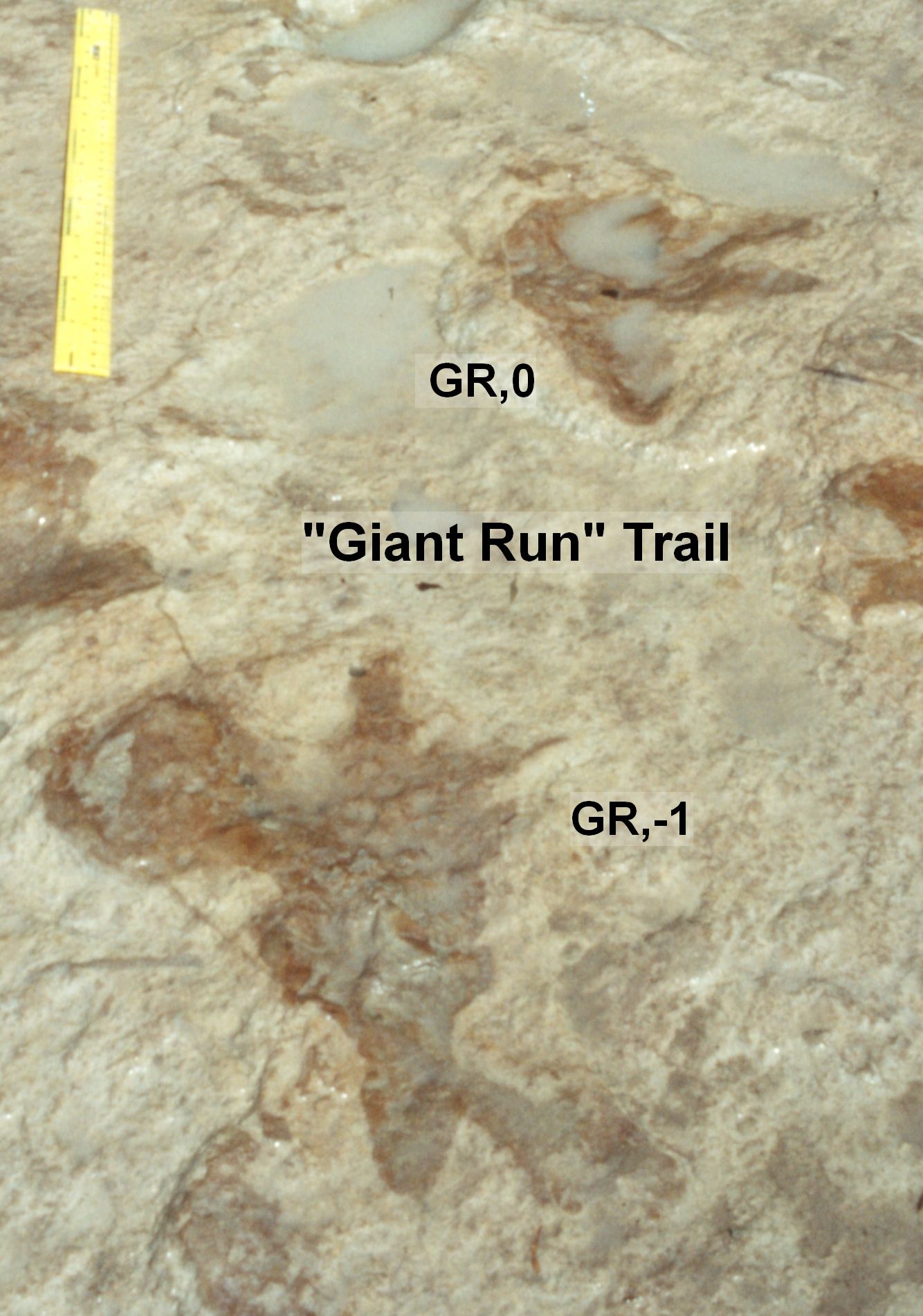 |
|
Giant Run (GR) Trail, under shallow water, from lower left to upper center.
|
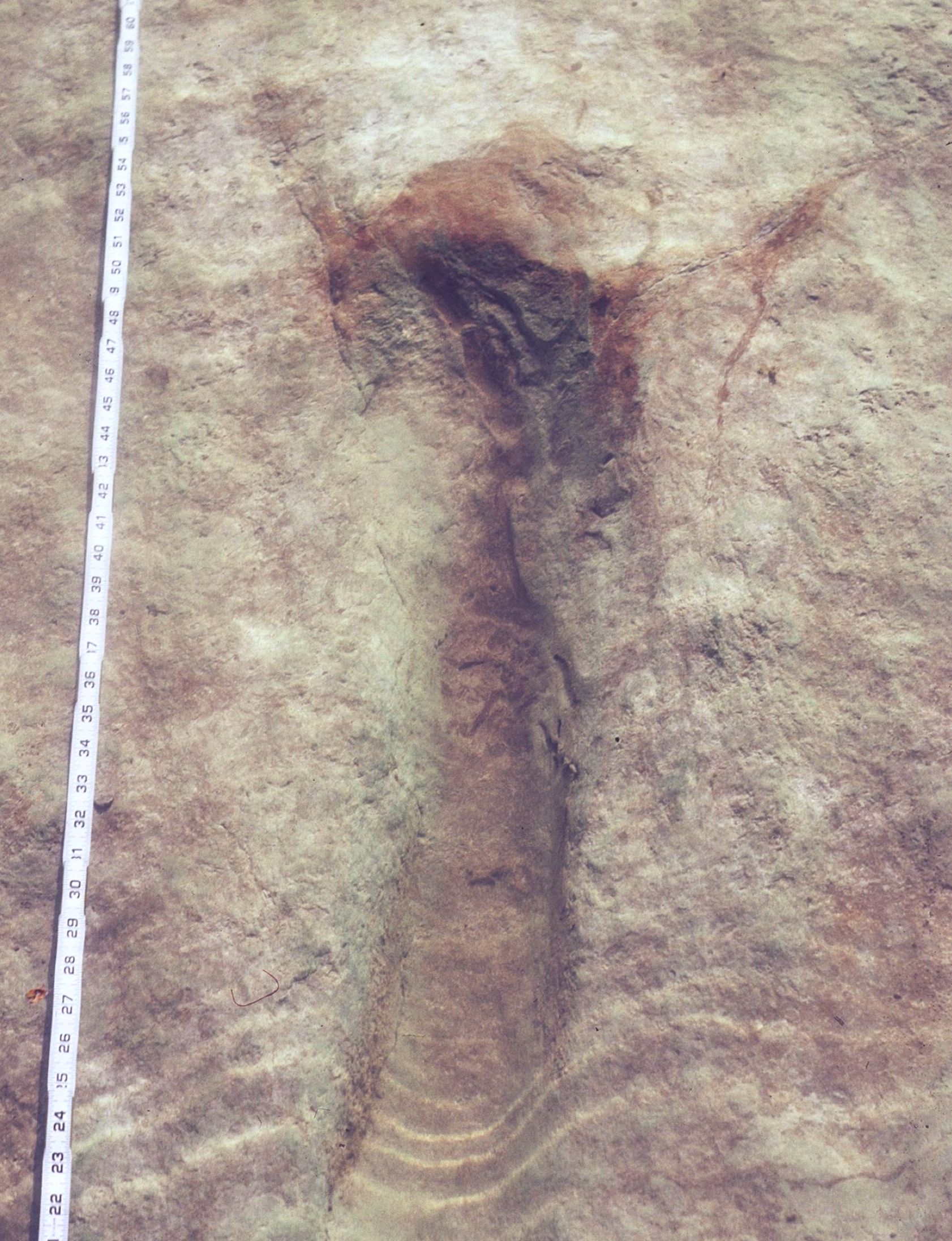 |
|
Ryals Trail track RY+4. YECs called this a human foot
slide, but infilling colorations indicate wide,
dinosaurian digits. |
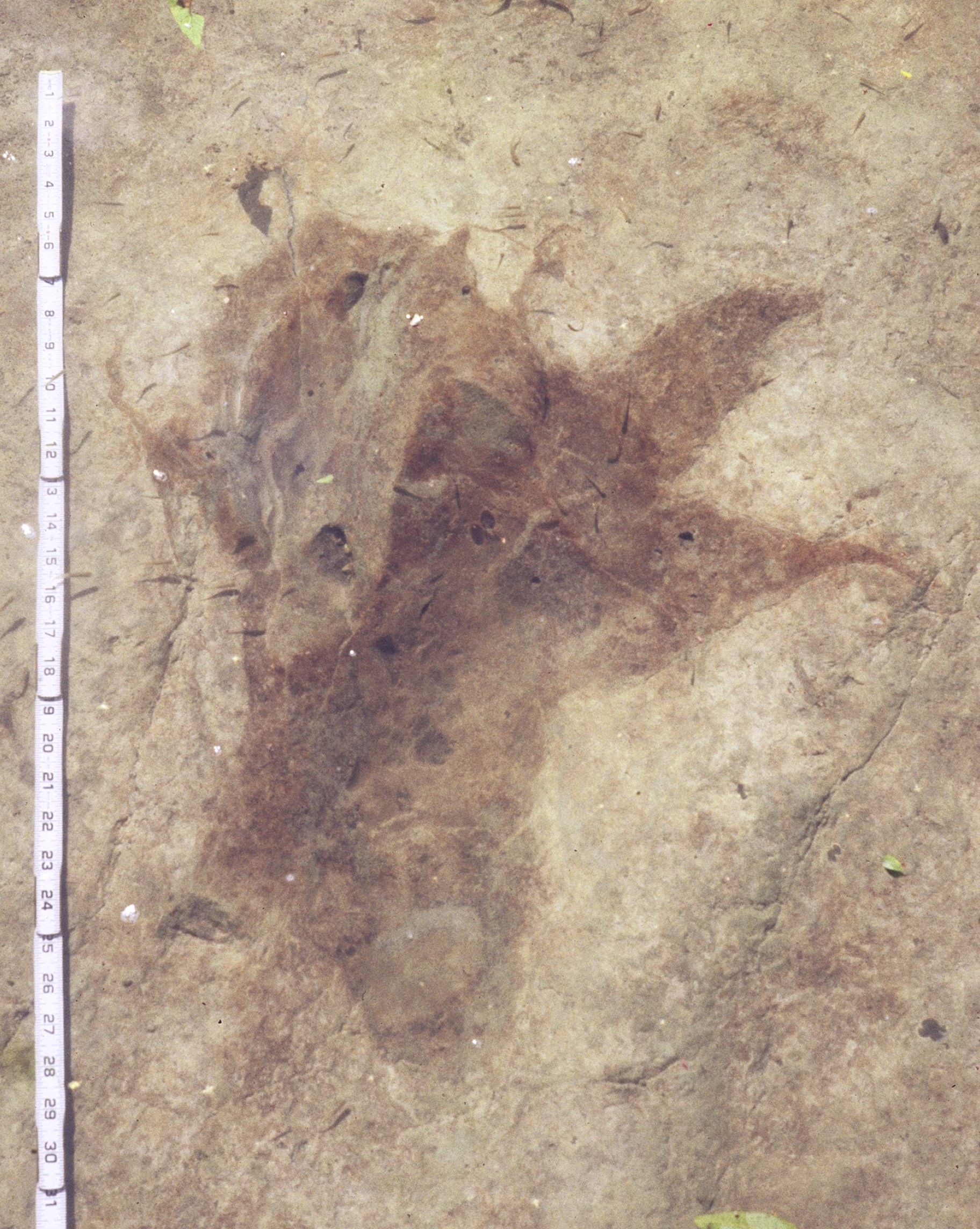 |
|
Once called "human", Ryals Trail track RY+5 (bottom to top)
overlaps IID,-11 track. Both are well infilled. |
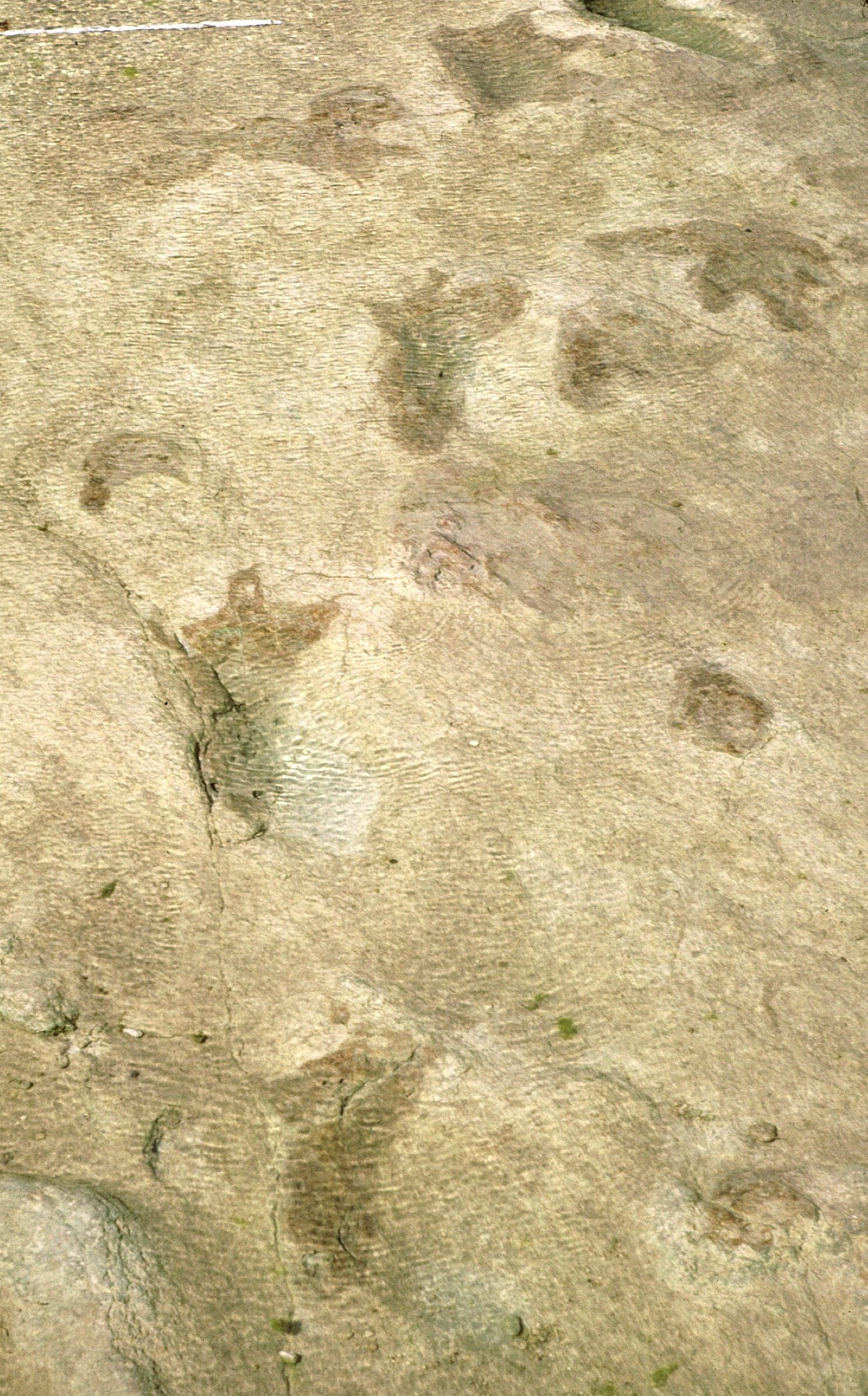 |
|
IIDW Trail. Long trail of infilled metatarsal
dino tracks never claimed to be human.
|
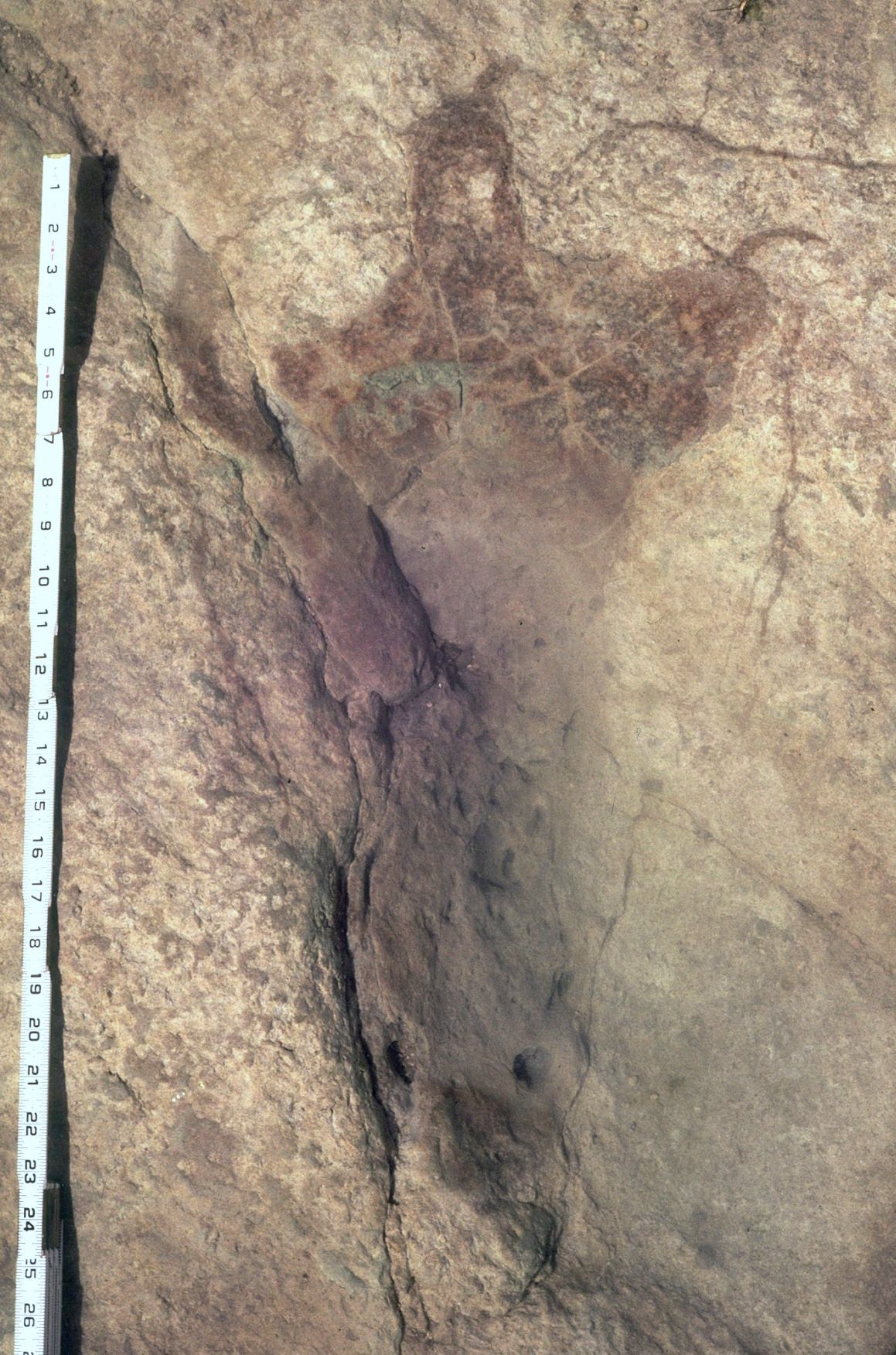 |
|
Track IIDW2 ("Mr Claw"), infilled metatarsal track
on Taylor Site with clear claws (never
claimed human)
|
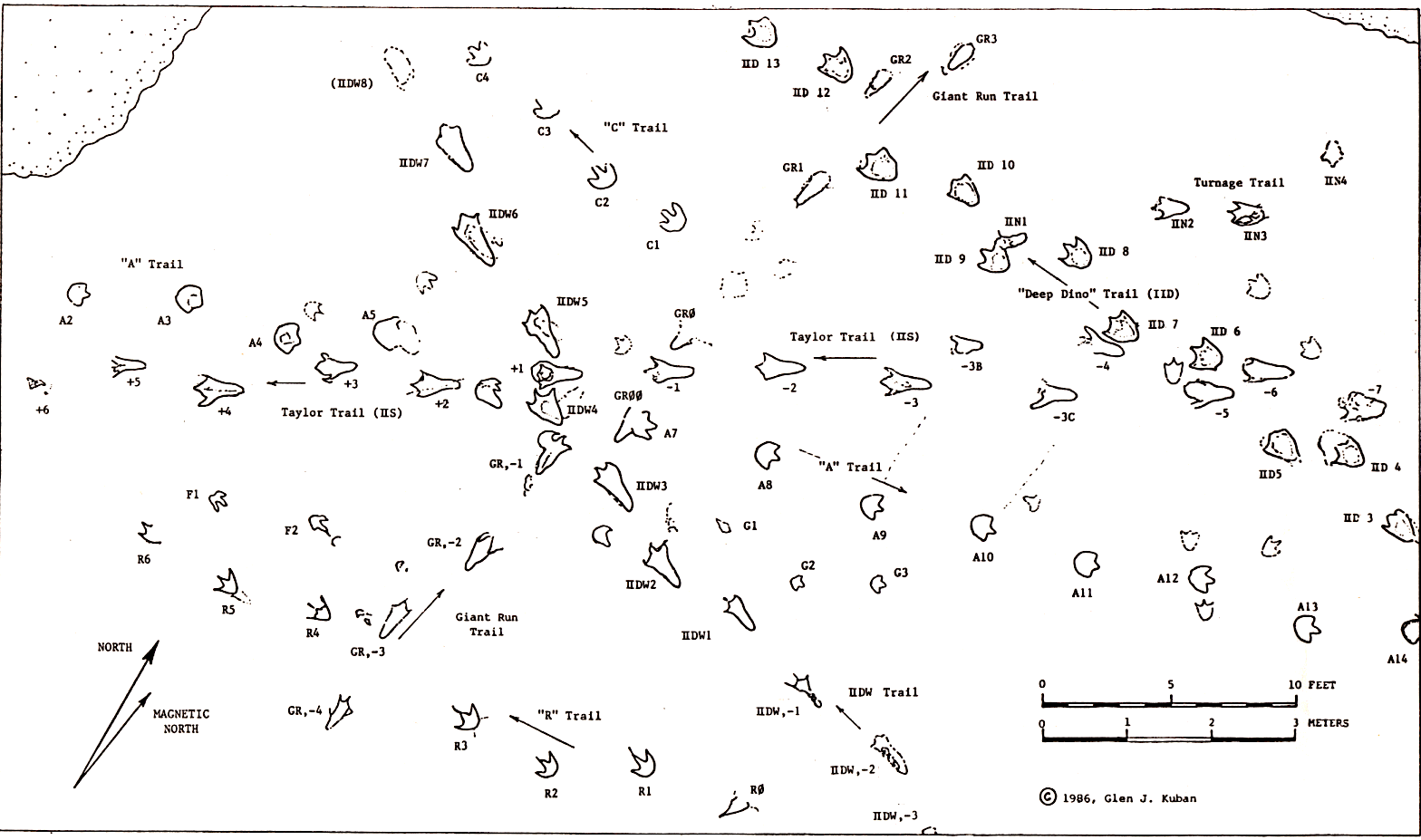 |
|
Taylor Site Map, central portion. (C) 1986, Glen J Kuban. Based on extensive measurements and photos 1980-1985.
|
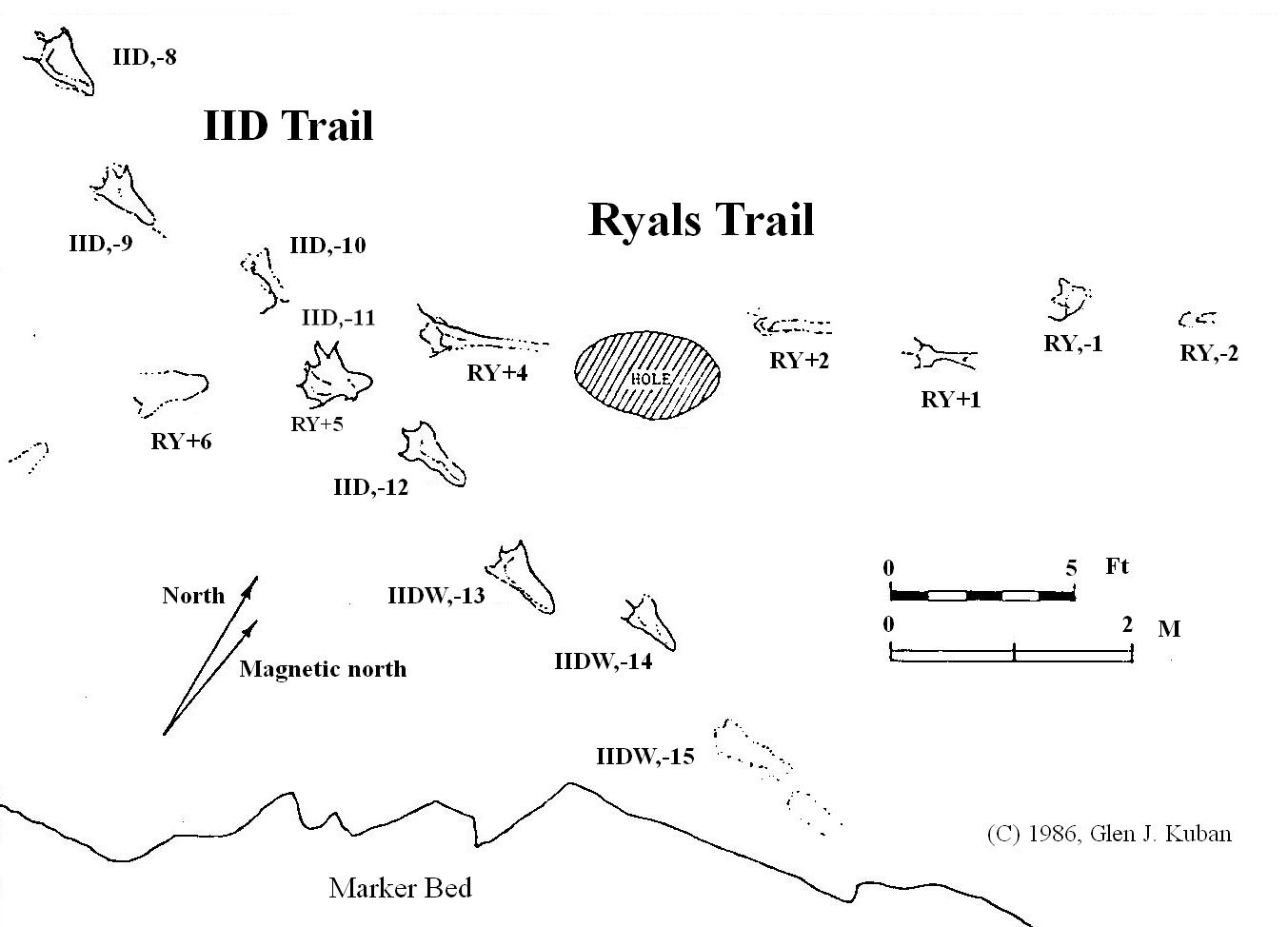 |
|
Map of the Ryals Trail (once called human) overlapping another metatarsal
dinosaur trail (IIDW). The large oval hole is where Jim Ryals
chiseled out "human" track in the 1930's. |
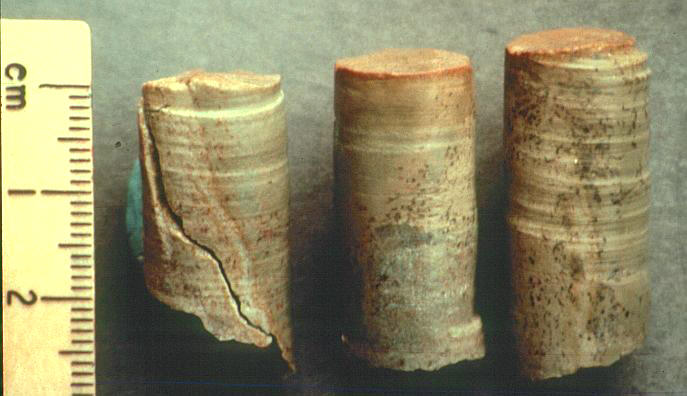 |
|
Core sections taken at margins of infilling, confirming
that the color distinctions relate to infillings
of the original track depressions. Note that the infillings extend
well into the subsurface. |
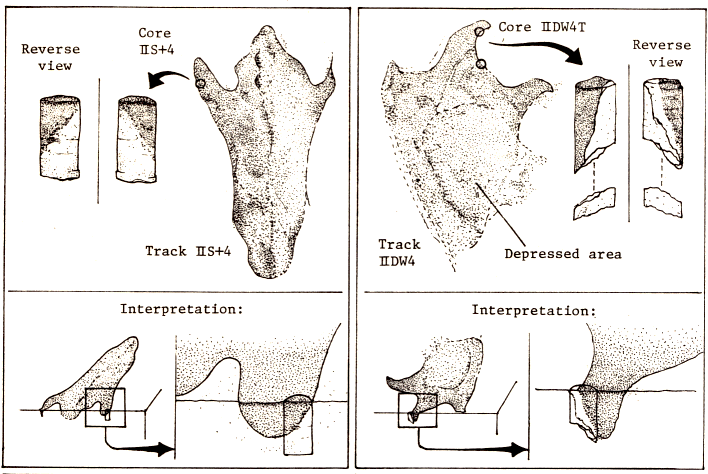 |
|
Diagram interpreting the core samples in relation to
the original track depressions. (C) 1986, Glen Kuban |
Metatarsal dinosaur tracks on other Paluxy sites
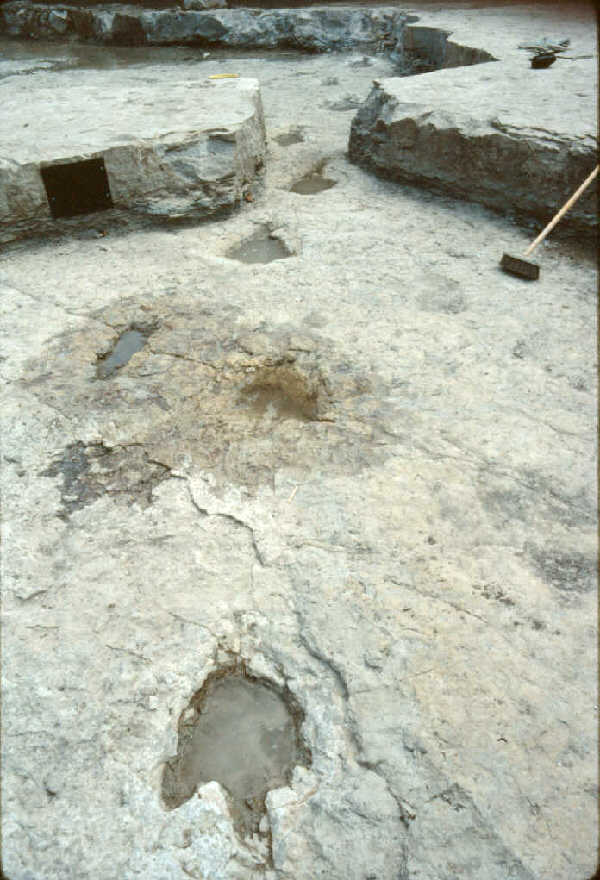 |
|
Carl Baugh's first "dig" on McFall Ledge, 1982.
Some of the dino tracks had partial metatarsal
impressions, which Baugh interpreted as human tracks
overlapping dinosaur tracks.
|
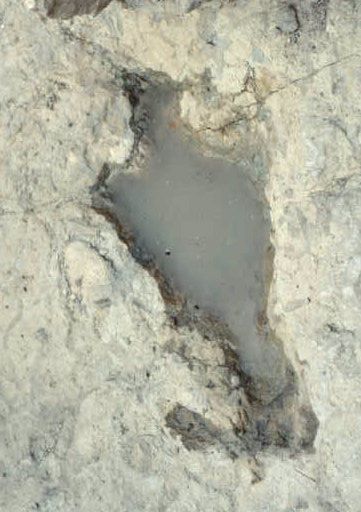 |
|
"Baughanthropus" track with partial metatarsal impression, promoted by Baugh
as a human track overlapping a dino track.
|
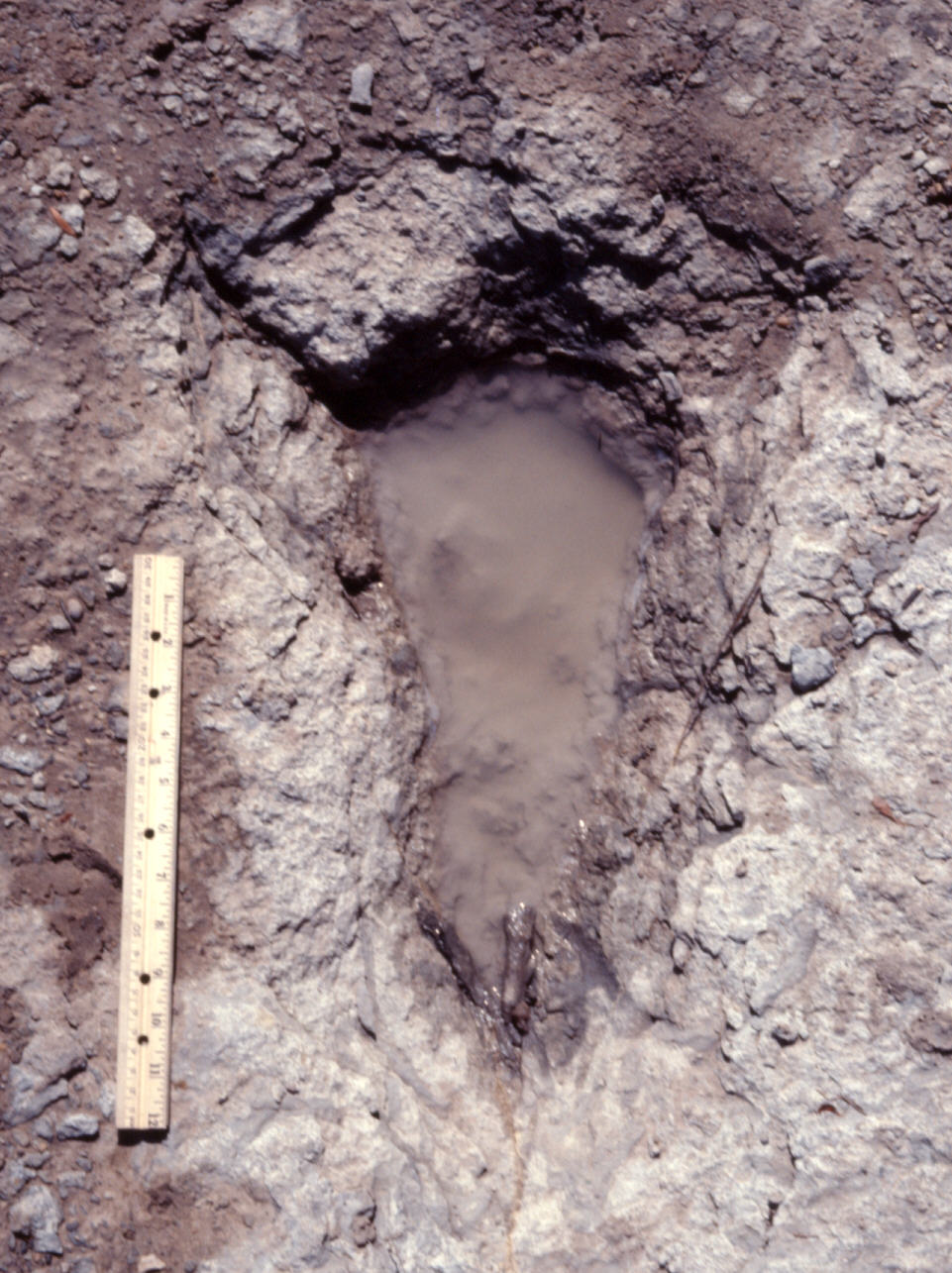 |
|
Eroded metatarsal dino track on the Baugh/McFall ledge. Promoted by some as a giant human footpring overlapping
a dinosaur track.
|
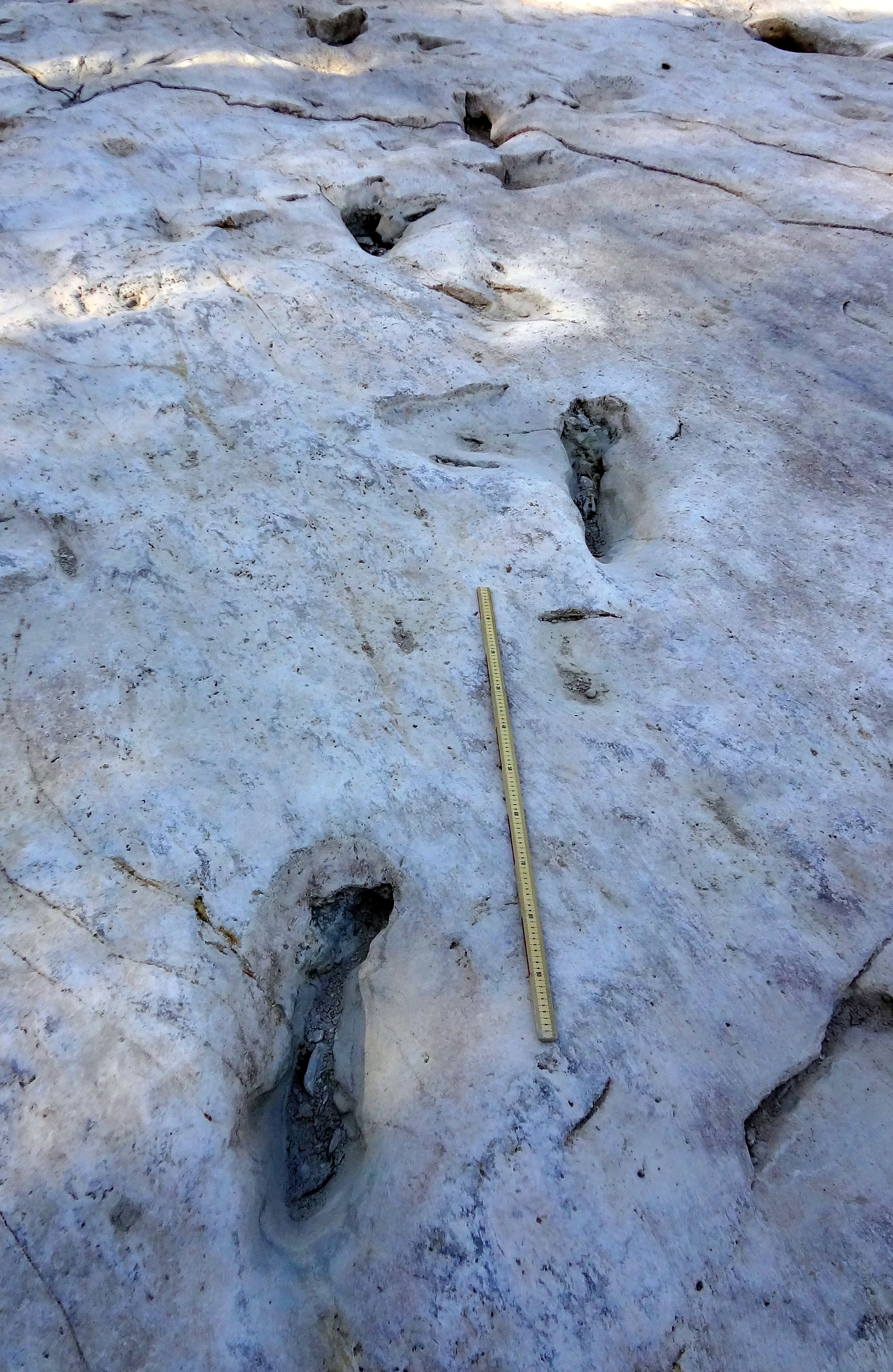 |
|
Mud-collapsed theropod dinosaur tracks at the Denio Site, once suggested by some creationists to
be giant "moccasin" prints.
|
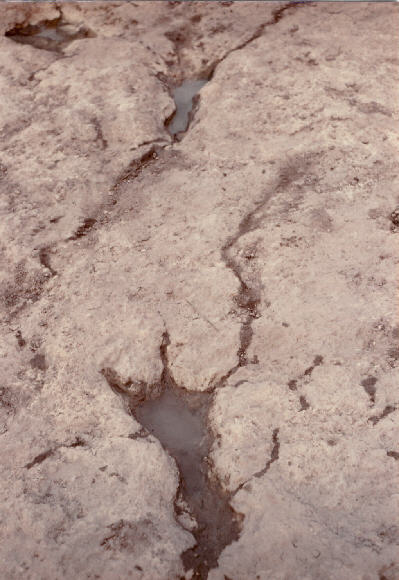 |
|
Portion of a metatarsal trackway at Al West Site.
Track IIDW13 at bottom is one of the best preserved metatarsal tracks in the Paluxy,
but the next in sequence is more mud-collapsed and thus somewhat more human-like (and could become
even more so with erosion and/or infilling).
|
 |
|
Distinct metatarsal dinosaur track IIW13. This track shows three
clear dino digits but the next in line is more mud collapsed
and thus somewhat human-like.
|
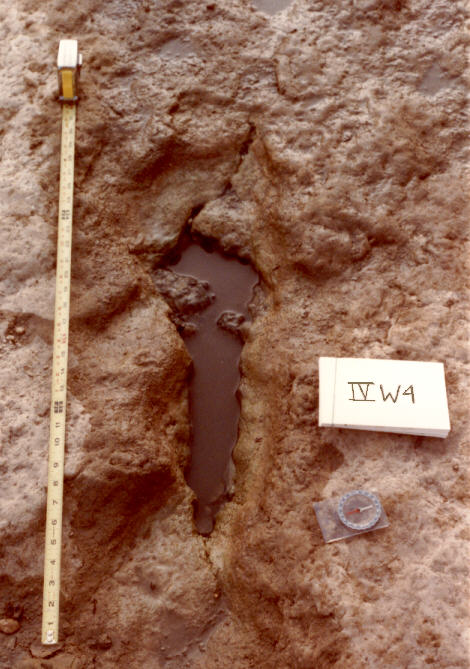
|
A mud-collapsed metatarsal dino track at Al West Site, showing a
superficially human-like shape, occurring in the same trail with more
obviously dinosaurian tracks.
|
========================
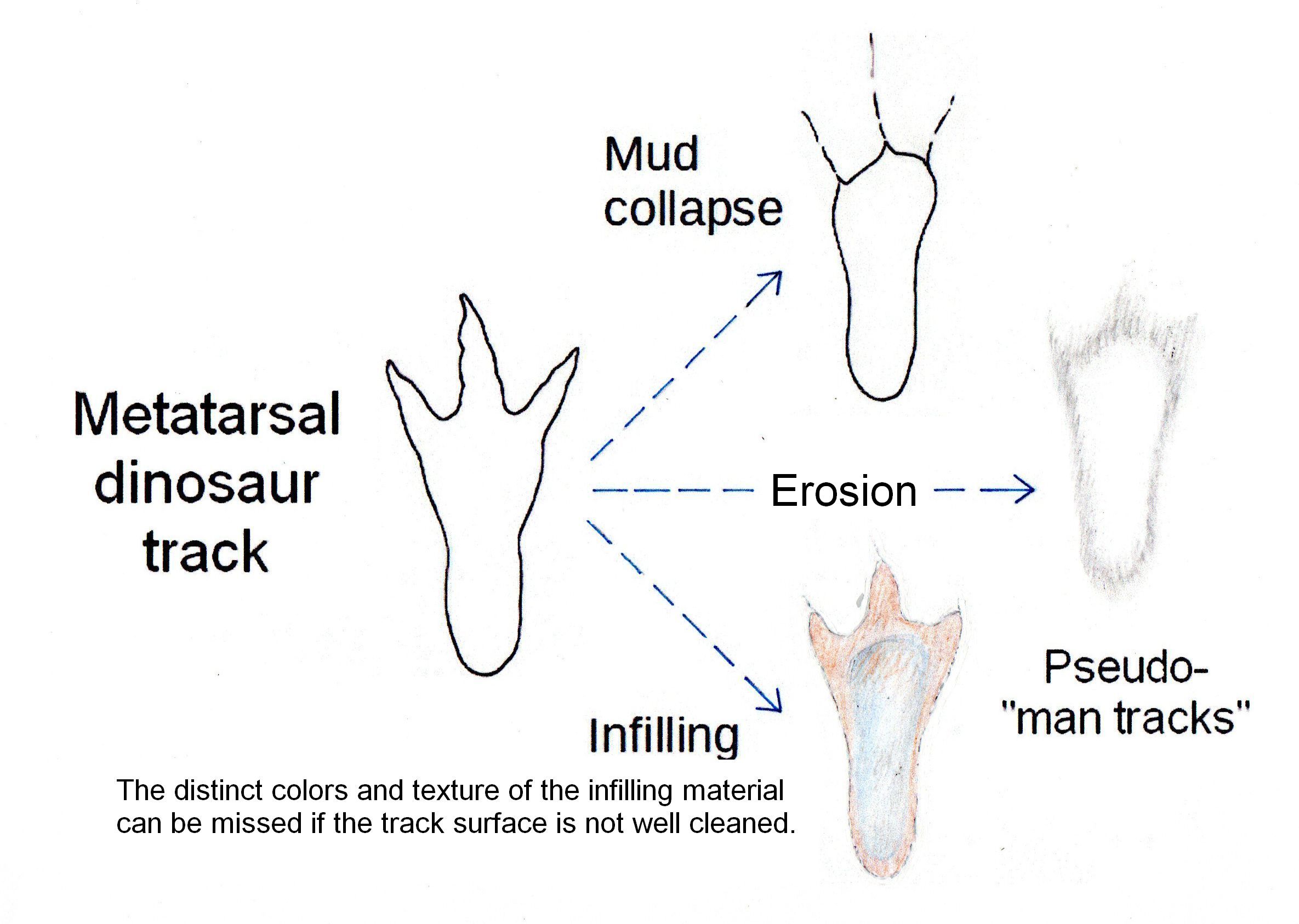 |
|
Diagram showing how a metatarsal
(heel-impressed) dinosaur track can become human-like
with infilling, mud-backflow, erosion, or a combination
of factors. |
 |
|
Metatarsal (heel-impressed) tracks may have been made by bipedal
dinosaurs contending with a soft and slippery supstrate, and/or
while foraging for small food items (fish, crustaceans, mollusks, etc)
in mud and shallow water. In the Paluxy most metatarsal tracks
were evidently made by a ornithomimid (ostrich mimic) or similar
gracile theropod dinosaur. Drawing (C) 2020, Glen J Kuban |
2. Erosional Markings
Other alleged "man tracks" involve erosional features and natural irregularities
of the rock surface (not real tracks of any kind) that were often selectively highlighted
with water or oil by YECs to encourage human shapes. Most have unnatural bottom countours
and overall shapes. A number of these features shown in Footprints in Stone and a number
of YEC publications in the 1970's and 80's occur on the "Park Shelf" of Dinosaur Valley State,
and are no longer promoted by most creationists. These mistaken irregularities as human tracks
evidently were secondary developments after certain locals and YECs mistook metatarsal dinosaur
tracks with indistinct or infilled difits for "giant human tracks", and then began to assume
that any remotely human-like marking in the Paluxy was also a human track.
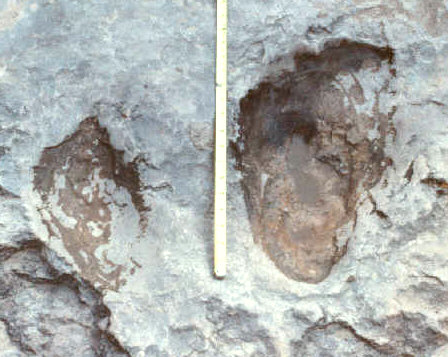
|
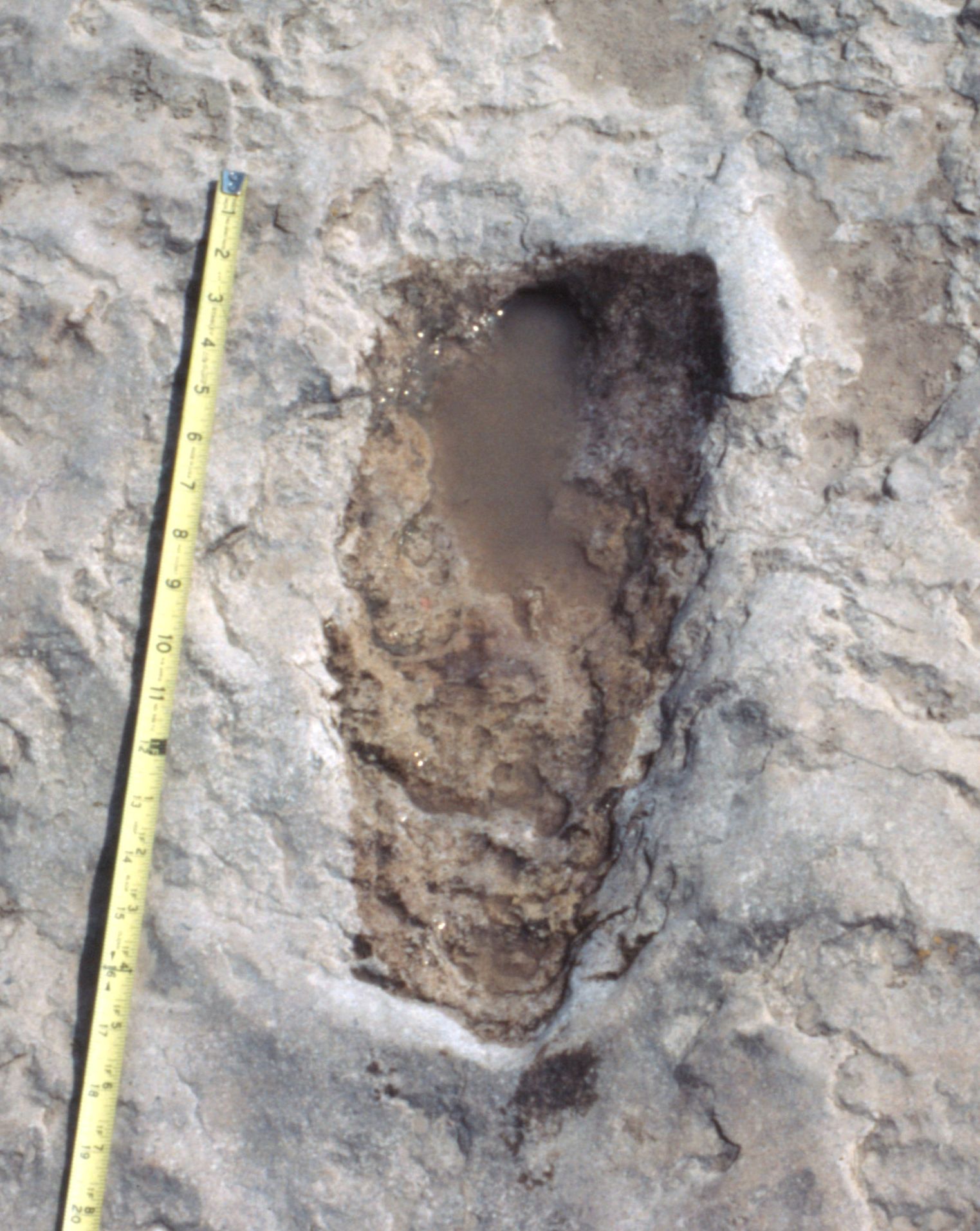
|
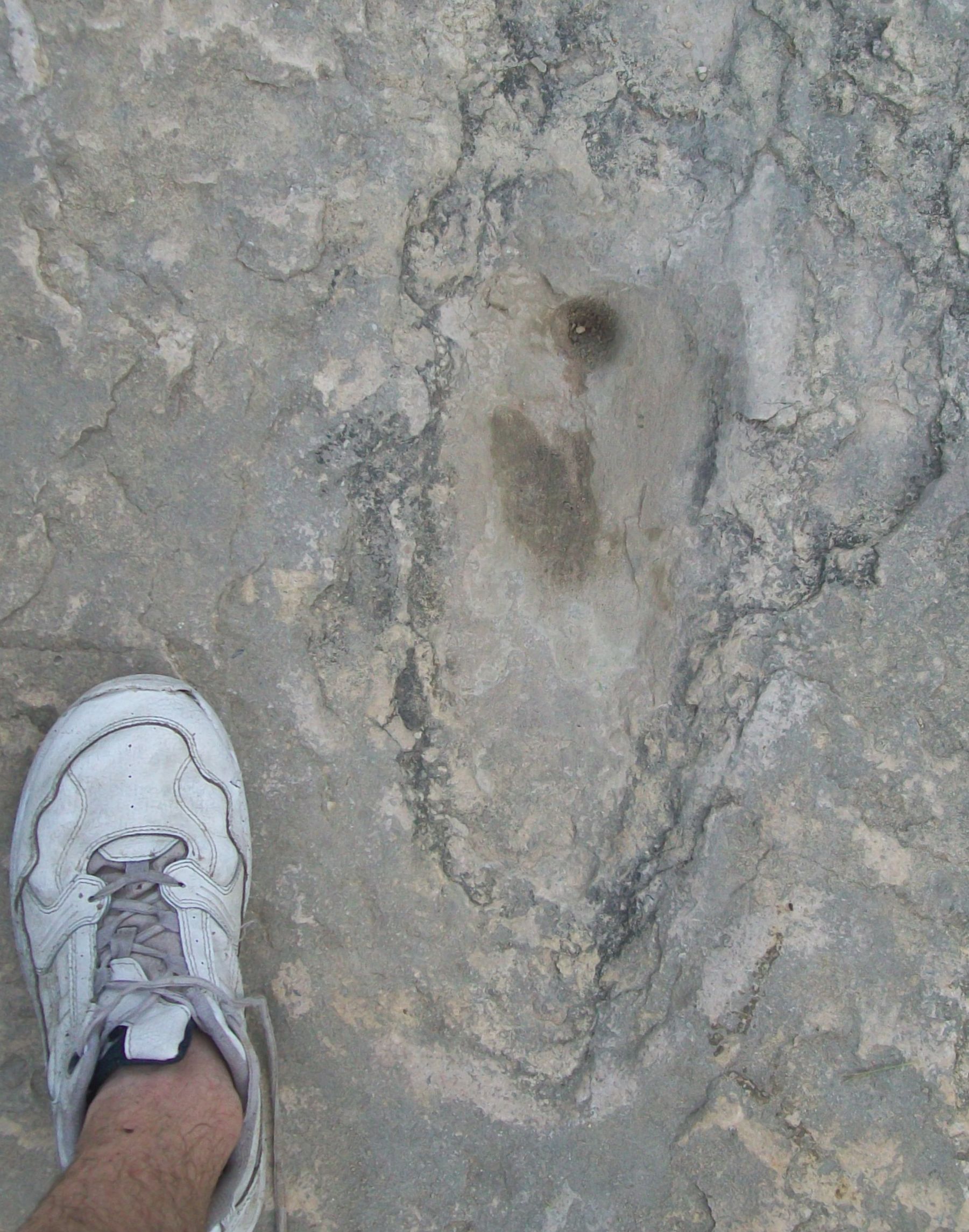
|
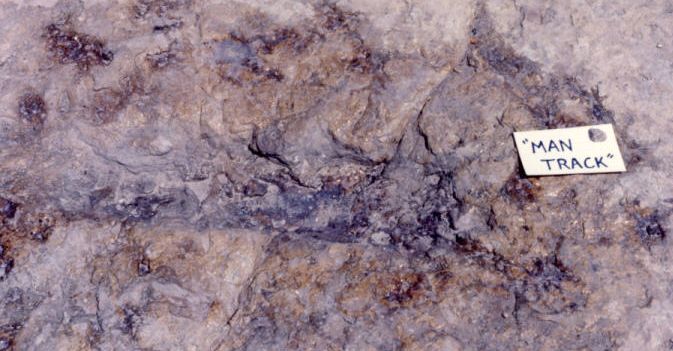
|
|
Erosional features on "State Park Shelf"
often selectively moistened to encourage human-like shapes. |
Erosional marking on "State Park Shelf" sometimes
moistened to appear human like. |
Same depression as shown in Fig. 3B without moistening |
Vague elongate irregularity on the McFall Ledge clained
by Carl Baugh to be a human footprint (1982).
|
3. Carvings
Several alleged Paluxy "man tracks" tracks are outright carvings that occur on loose blocks of rock.
Most are "giant" sized (over 15 inches long), show unnatural shapes and features (including abberant
shapes, bottom contours, and "toes"). Most were carved by Glen Rose local resident
George Adams in the 1930's, as acknowledged by Adam's family. Evidently Adams decided to create
better examples of the supposed giant human tracks in the riverbed in order to sell to tourists
and passers by during the Great Depression. Several of these carvings have
have been cross-sectioned, revealing subsurface features that abruptly truncate at the
track depression, confirming their carved origin. Included among these is the
"Burdick Track", once promoted by Clifford Burdick, and still promoted by a few YECS (especially
Carl Baugh and Don Patton) a real "giant human track". Two similar carvings (probably also by Adams)
were seen in a trading post window by paleontologist Roland Bird in the late 1930's which led him to Glen Rose to investigate
why someone would have carved them (and a carved dinosaur track being displayed with them)--
resulting in his later excavating long trails or real dinosaur tracks, including the first
officially identified sauropod ("brontosaur") tracks.
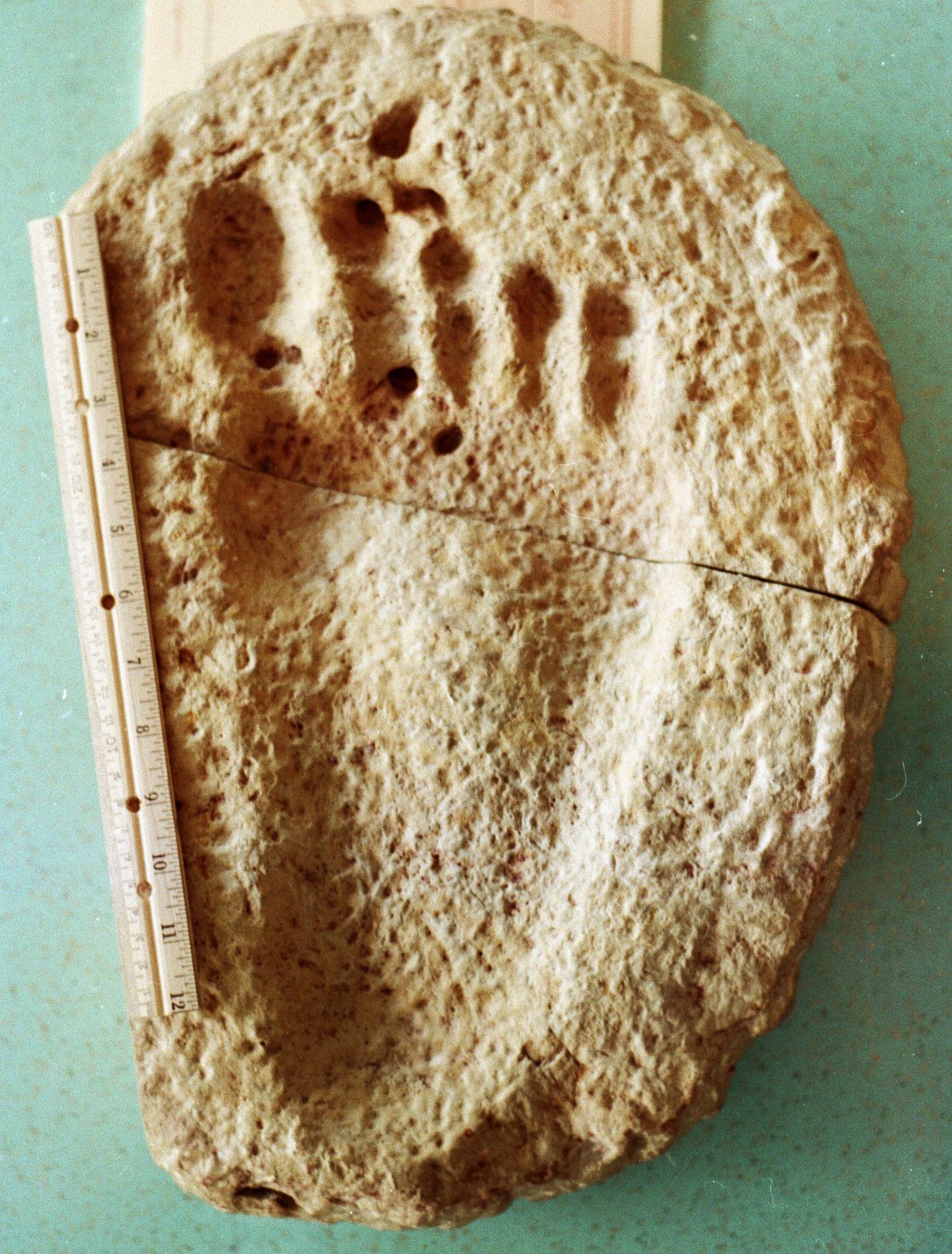
|
Figure 4A.
The "Burdick Print". One of George Adam's carvings
from the 1930's. Note abnormal toes,
misplaced ball, and unnatural overall shape.
|
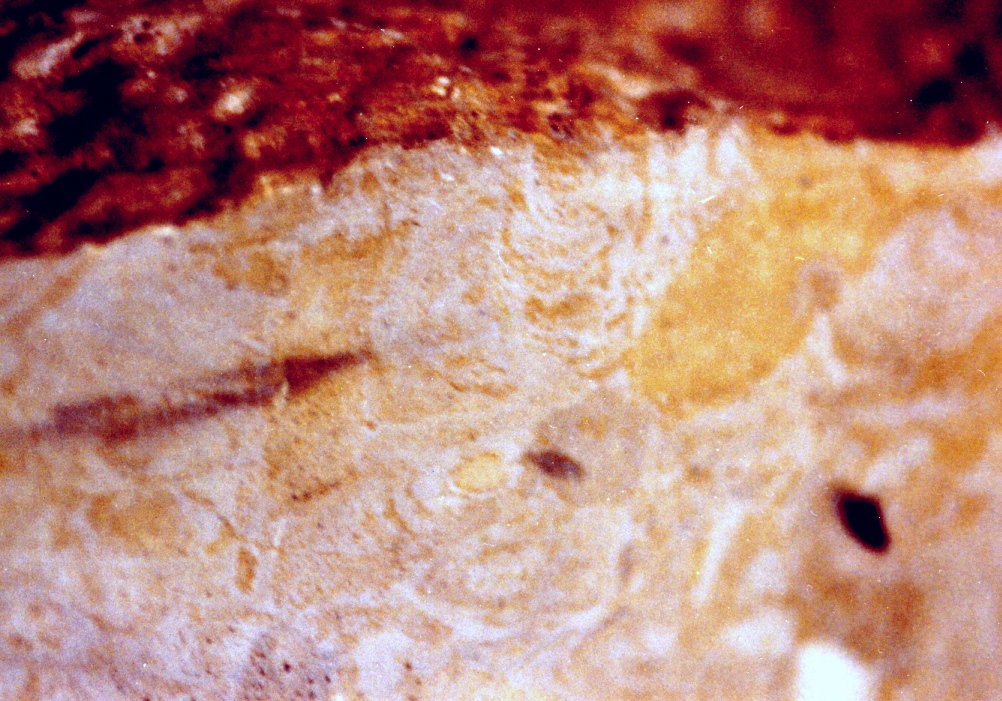
|
|
Figure 4B. Cross section through ball area of Burdick Print.
Note truncated subsurface features, which include algal structures
and fossil fragments, confirming a carved origin.
|
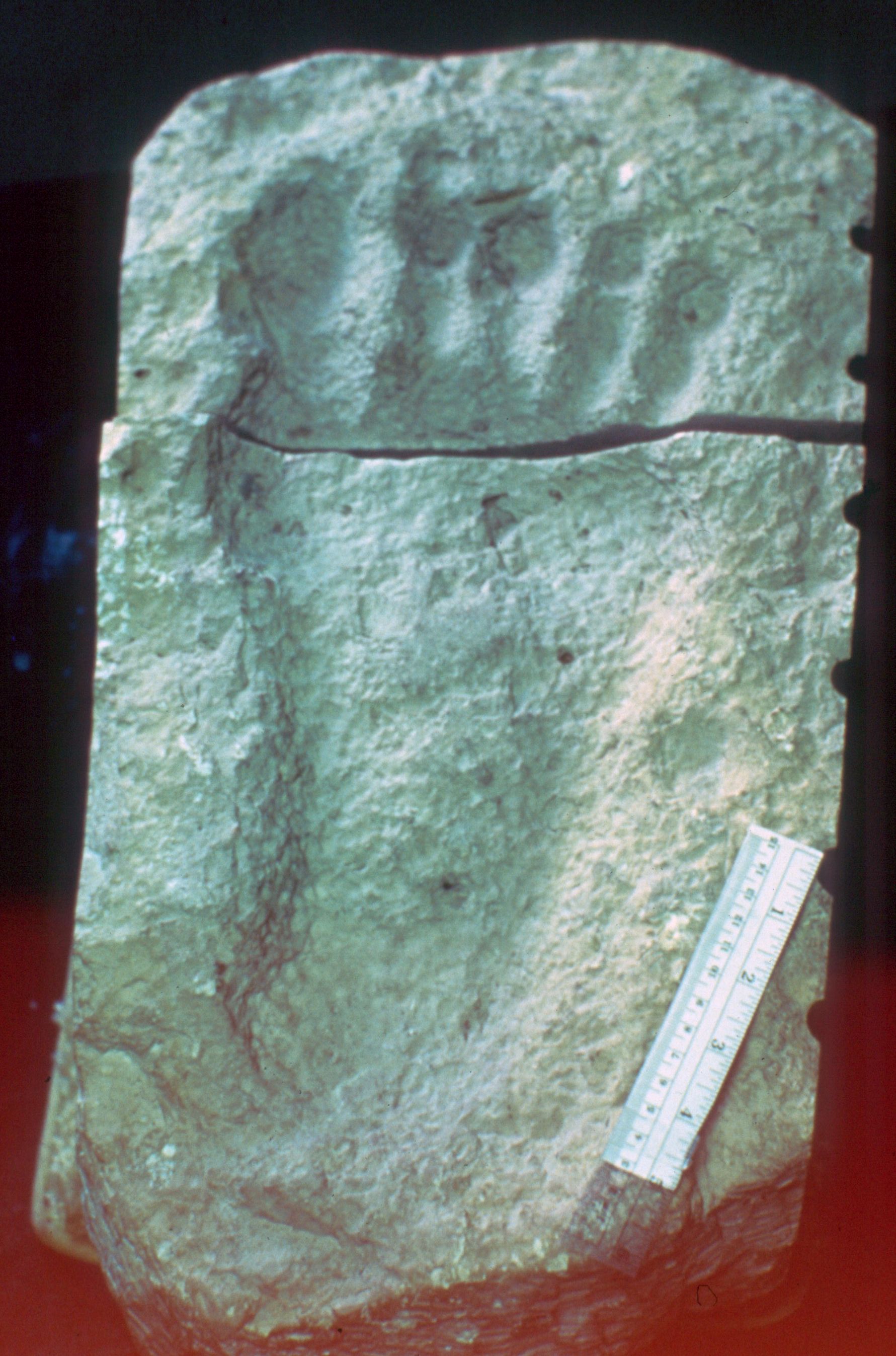
|
|
Figure 4C. The "Gallup Right" print. Seen
by Roland Bird in a trading post in 1938.
Note similar carving style to Burdick print.
|
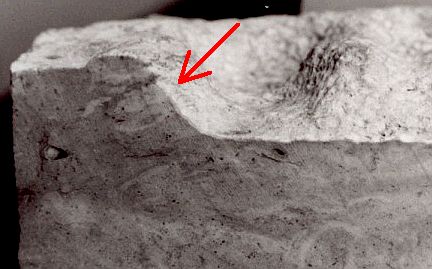
|
|
Figure 4D. Gross section through the "Gallup Right"
print, showing subsurface features truncated by the print
depression (see arrow) confirming its carved origin.
|
Carvings and doctored depressions in the field
A handful of alleged human tracks were natural irregularities of the rock surface or parts of dinosaur
tracks that were selectively manipulated to encourage human shapes, which can be considered carvings
or partial carvings at least in a loose sense. Most of these were done by
Carl Baugh during the 1980's, who would sometimes abrade gouge into the track bed surface, or
manipulate firm clay or marl not completely removed from depressions or dinosaur tracks on it, to
foster the appearance of human shapes and "toes" (often under the pretense of cleaning out the
depressions). The coarse nature of the track bed at the McFall Ledge where Baugh often worked
was conducive to these shady practices. Not only has this been witnessed by a number of participants in Baugh's "digs", but
he even recorded himself doing it in one of his early video's entitled "Enemies Survived Together For a While."
Unfortunately for Baugh, he was not a good artist, and even after his best efforts, the results were far
from natural looking or convincing.
The most extreme example was an alleged "giant man track" gouged into the firm clay over the
limestone by Carl Baugh in 1933, which Baugh nicknamed "Max." The bottom of the "footprint" was largely rock, but the sides
and toes were created by gouging into the firm marl (limy clay) that covered the track bed here.
Besides being monstrously large (over 25 inches long) it's toes, bottom contours, and overall shape
were very unnatural. Almost no YECs except a couple close associates accepted it, so Baugh soon
stopped promoting it.
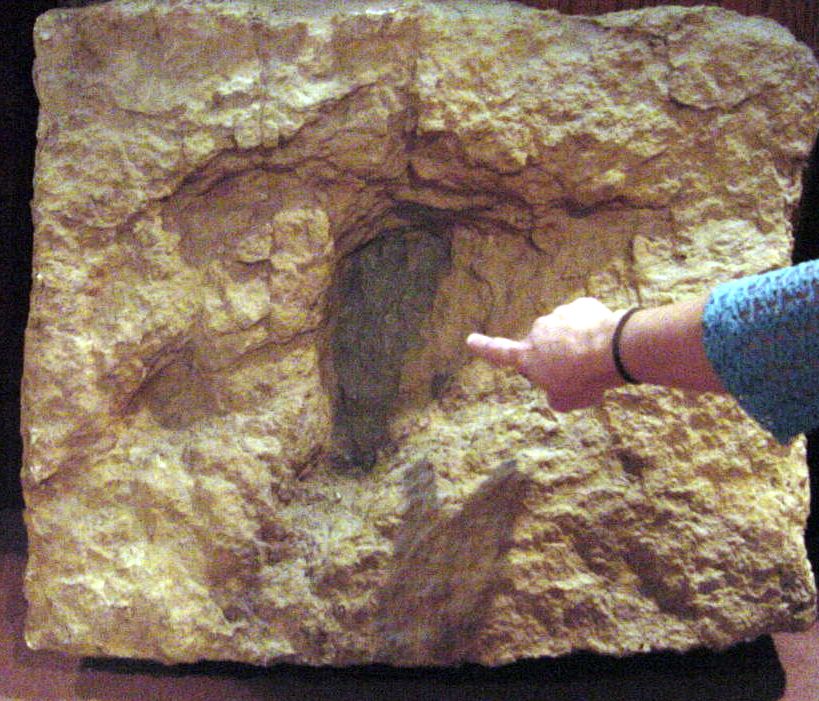 |
|
Alleged human track inside a dinosaur track from the
Baugh/McFall ledge, displayed in Baugh's "Creation Evidence Museum."
Note the rough contours, and lack of proper bottom countours
or normal looking toes on the "human" print (there appear to be only four toes even with selective moistening).
|
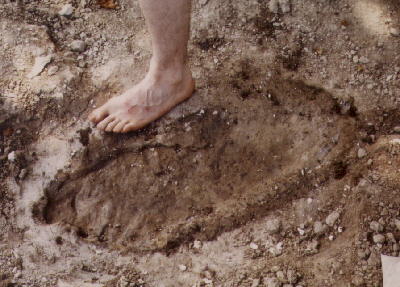 |
|
Baugh's so-called "Max" alleged giant human footprint.
Besides its immense size and unnatural features (especially
the bizarre toes and lack of normal bottom contours), I
confirmed confirmed in person that the print margins
were entirely composed of marl (firm limy clay)
above the track bed that had been gouged out to
create a roughly human-like shape. |






















